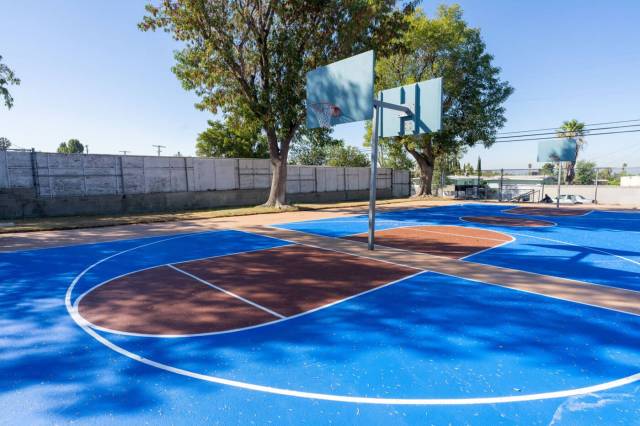Street murals created with solar-reflective paint are cooling down Los Angeles.
If you've ever scorched your feet walking barefoot on a sun-baked concrete driveway, you're familiar with how powerful a heat-trapping agent like pavement can be as compared to, say, grass.
Now, take that foot-scorching hot driveway and multiply it to cover an entire city with little to no green spaces and you've got an urban heat island.
In major cities like L.A., pavement, buildings, and other infrastructure absorb far more heat from the sun than suburban areas filled with trees and bodies of water.
When urban pavement and concrete release heat absorbed from the sun back into the surrounding air, temperatures increase a lot. Cities can be as much as seven degrees warmer during the day than outlying areas.

An unlikely cooling solution in street murals
To combat rising temperatures in a Los Angeles neighborhood, North America's largest waterproofing and roofing company, GAF, began a research project to evaluate the heat island effect and to test efforts to reduce urban heat. For the first phase of this project, GAF chose the San Fernando Valley's Pacoima neighborhood, one of the hottest areas in L.A.
This initiative, called the GAF Cool Community Project, included partners from Climate Resolve, the Global Cool Cities Alliance, local community organizations, and municipal governments.
The GAF Cool Community Project began its cooling attempts by assessing the effectiveness of using solar-reflective paint on various surfaces to lower temperatures in Pacoima.
Where regular pavement would absorb and re-emit heat from the sun, solar-reflective paint works by reflecting this heat and reducing surface-level temperatures.
This weekend we got to celebrate the GAF Cool Community Project in Pacoima! 10 square blocks of street, a school playground, a mural design & a recreation center parking lot will be painted with a cool coating. This coating will help us combat extreme heat in our community! pic.twitter.com/8zTtaOxltn
— Pacoima Beautiful (@PB__Community) July 25, 2022
The GAF Cool Community Project painted one million square feet of school playgrounds, streets, parking lots, and community parks to lower temperatures in this neighborhood. This project commissioned artists to paint some locations, like a school playground and a basketball court.
TCD Picks » Upway Spotlight

The data collected showed these painted surfaces reduced the temperatures in Pacoima by 10 to 12 degrees.
Maria Koetter, Executive Director of the Global Cool Cities Alliance, said the goal of this project was to advance programs that promote "healthy and resilient cities" and those that can reduce the harsh effects of rising temperatures.
This is a simple solution to the complex problem of rising temperatures across the globe. The hope for the GAF Cool Community Project is that other cities will be able to make this small change on their streets to relieve their communities of the burdens of sweltering temperatures.
Why we need city-cooling solutions
Swelteringly hot urban centers cause a litany of problems for both city dwellers and those who live in surrounding areas.
For starters, hotter temperatures forced city-dwellers to spend more money on increased energy usage. As electricity bills skyrocket from rising prices of dirty energy, running A/C to keep cool is taxing Americans — especially the one in five city-dwellers who live below the poverty line.
And increasing dirty energy use means more harmful pollutants get pumped into the air, producing smog and aggravating respiratory issues in cities and their surrounding areas, too.

Warmer cities also throw off the delicate balance of natural bodies of water. As rain collects over heat islands, it warms and runs off into nearby bodies of water. Even a slight increase in temperature from urban runoff like this can disrupt the food chain and harm aquatic wildlife.
Most importantly, increased temperatures in the city and people's homes can increase the risk for heat-related illnesses or worsen pre-existing health conditions, ultimately lowering the quality of life in cities.
Nearly 85% of the U.S. population lives within a metropolitan area, and many don't have the resources to move out of the city to avoid the problems resulting from the heat island effect.
It's imperative to find solutions that will cool cities and protect and improve the lives of the majority of Americans.

Join our free newsletter for weekly updates on the coolest innovations improving our lives and saving our planet.














